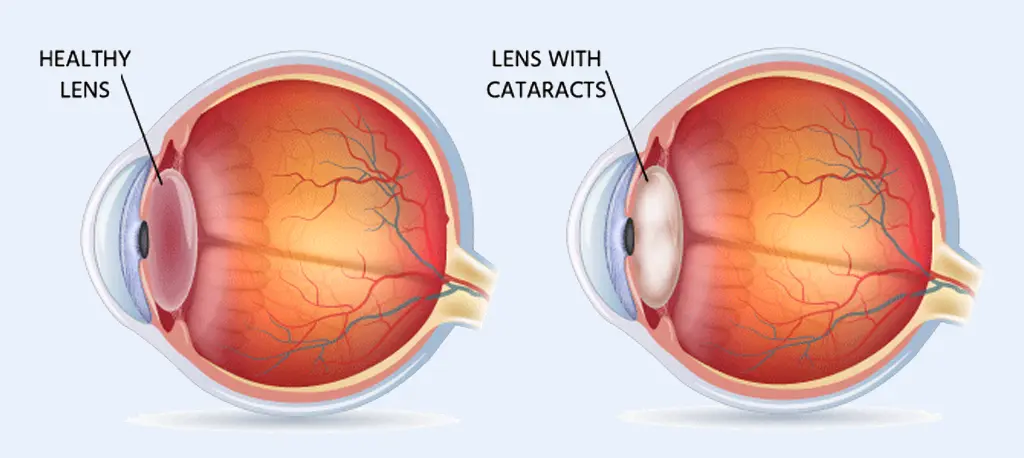BEST CATARACT SURGEON IN JABALPUR
Dr Vivek Arora is an excellent Cataract Surgeon in Jabalpur who is well-known nationally as well as internationally for his expertise in conducting cataract surgery. The chosen Roshan Netralaya surgeon has many years of experience in this field and performed more than 2 million eye surgeries and cataract operations all over the world.

What is cataract?
Our eyes consist of lens which helps us to see. As we grow old the natural crystalline lens becomes harder and loses its natural flexibility to focus on things at varying distances and creates vision problems. Gradually, the lens turns cloudy and your natural lens becomes like a window that is frosted or yellowed.
Cataract is a cloudy area in the lens inside the eye which is normally clear. Cataract can develop in one or both eyes.
Cataracts are most often caused by our body’s natural aging process, although they can also be the result of heredity or accidents.
A painless blurring of vision
Cataract leads to blurred, fuzzy and hazy vision while normal vision ensures crisp, clear well-defined images.
Light sensitivity
Cataract leads to reduced light sensitivity resulting in glare and undefined images.
Double vision in one eye
Cataract may lead to double vision in one eye, resulting in difficulty while driving and doing other day to day activities.
Some other symptoms of cataract are:
- Poor night vision
- Changes in the way you see colors
- Glare in front of eyes while driving
- Difficulty in identifying faces from distance
Cataract surgery involves removing the cataract and replacing with an artificial lens implant.
When you visit our OPD, our doctor will test your eyes to check how well you can see. The doctor will dilate your pupil in order to examine the condition of the lens and other parts of the eye and suggest the treatment accordingly. While you can bring your glasses or lenses along, it is advisable not to come for the surgery with your contact lens on.
The counseling department will then brief you about the surgery and run fitness & safety tests to ensure you are fit for the operation. You will be given a surgery date by the healthcare team.
The healthcare team at NIO will carry out a number of checks to make sure you have the operation you came in for and on the correct side. You can help by confirming to your surgeon and the healthcare team your name and the operation you are having.
Recent advances in the conventional phacoemulsification cataract surgery procedures have gradually reduced the size of the incisions needed for the surgery from 12 mm to 2.8 mm, making it safer and less invasive.
MICS is the advanced, state-of-the-art technique for treating cataracts. In this type of surgery, the cataract is emulsified using sound waves through a micro incision.
In MICS, incision of 1.8 mm to 2.2 mm is required to perform the entire cataract surgery procedure. The micro incision heals fast, enabling you to recover quickly.
- Benefits of MICS
- Safe and reliable surgery
- Improved patient comfort as the surgery is gentler and less invasive
- Prevents unwanted interferences to vision known as astigmatism
- Faster healing and recovery time
Once the natural lens from the eye is removed, it is replaced with an artificial lens know as intraocular lens (IOL). This lens focuses light on the retina and restores clarity of vision. Aspheric lens and non- aspheric lens are two main types of intraocular lens (IOL).
Aspheric lens
Traditional IOLs are spherical and have their front surface uniformly curved. Aspheric IOLs are slightly flatter in the periphery and are designed to provide better contrast sensitivity.
Let’s take a look at some of the types of aspheric lens-
- Accommodative lenses / Multifocal
The lenses with multifocal or accommodative designs provide vision at multiple distances and help the patient reduce dependency on glasses. Studies have shown that majority of patients (8 out of 10) can achieve this
- Toric lenses
These are a special variety of lenses designed with an aim to reduce dependency on glasses, and reduce high cylindrical number (astigmatism)
- Monofocal
Non-aspheric (traditional) lens
Non-aspheric lenses are lenses whose surfaces are parts of a plane or parts of a sphere. Compared to aspheric lens, non aspheric lens are simple and relatively cheaper.
IOL power calculations at NIO are done by trained personnel and every endeavor is made to minimize errors. This is done using Ziess IOLMaster and or ultrasound biometry.
